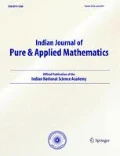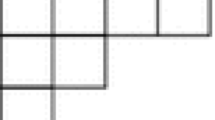Abstract
In 2013, Baruah and Sarmah, and Xia and Yao independently obtained generating function for the sequences p−8(2n + 1) and p−8(4n + 3), where p−8(n) counts the number of partitions of n in eight colours. In this article, we generalize the identities and as a consequence, establish several Ramanujan type congruences modulo higher powers of 2.
Similar content being viewed by others
References
C. Adiga and D. Ranganatha, On overpartition pairs into odd parts modulo powers of 2, Discrete Math., 341 (2018), 3141–3147.
G. E. Andrews, The Theory of Parititions, Cambridge University Press, Cambridge, (1998).
A. O. L. Atkin, Ramanujan congruences for pk(n), Canad. J. Math., 20 (1968), 67–78.
N. D. Baruah and B. K. Sarmah, Identities and congruences for general partition and Ramanujan’s tau functions, Indian J. Pure Appl. Math., 44 (2013), 643–671.
B. C. Berndt, Ramanujan’s Notebooks, Part III, Springer-Verlag, New York, (1991).
B. C. Berndt and K. Ono, Ramanujan’s unpublished manuscript on the partition and tau functions with proofs and commentary, Sem. Lothar. Combin., 42 (1999), 1–63.
M. Boylan, Exceptional congruences for powers of the partition function, Acta Arith., 111(2004), 187–203.
B. Gordon, Ramanujan congruences for pk (modllk), Glas. J. Math., 24(2) (1981), 107–123.
M. D. Hirschhorn, Partitions in 3 colours, Ramanujan J., 45(2) (2018), 399–411.
M. D. Hirschhorn and D. C. Hunt, A simple proof of the Ramanujan conjecture for powers of 5, J. Reine Angew. Math., 326 (1981), 1–17.
I. Kiming and J. B. Olsson, Congruences like Ramanujan’s for powers of the partition function, Arch. Math., 59(4) (1992), 348–360.
S. Ramanujan, Some properties of p(n), the number of partitions of n, Proc. Cambridge Philos. Soc., 19 (1919), 207–210.
S. Ramanujan, The lost notebook and other unpublished papers, Narosa Publishing House, Bombay, (1988).
G. N. Watson, Ramanujans Vermutung über Zerfällungszahlen, J. Reine Angew. Math., 179 (1938), 97–128.
E. X. W. Xia and O. X. M. Yao, Analogues of Ramanujan’s partition identities, Ramanujan J., 31 (2013), 373–396.
Acknowledgement
We would like to thank the referee and editor for comments. The second named author was partially supported by the University Grants Commission of India, under the Start-Up Research grant no. F.30-489/2019(BSR).
Author information
Authors and Affiliations
Corresponding authors
Additional information
Dedicated to Prof. Chandrashekar Adiga on the occasion of his 62nd birthday
Rights and permissions
About this article
Cite this article
Hemanthkumarm, B., Ranganatha, D. & Bharadwaj, H.S.S. On Eight Colour Partitions. Indian J Pure Appl Math 51, 1843–1856 (2020). https://doi.org/10.1007/s13226-020-0500-y
Received:
Accepted:
Published:
Issue Date:
DOI: https://doi.org/10.1007/s13226-020-0500-y



